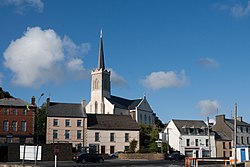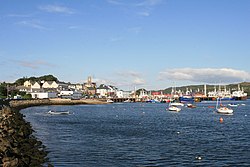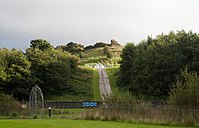Killybegs
| Killybegs Irish: Na Cealla Beaga | |
| County Donegal | |
|---|---|
 Killybegs skyline | |
| Location | |
| Grid reference: | G711767 |
| Location: | 54°38’10"N, 8°26’40"W |
| Data | |
| Population: | 1,236 (2016) |
| Local Government | |
| Dáil constituency: |
Donegal |
Killybegs is a town on the coast of County Donegal and is the largest fishing port in the country.
The town is on the south coast of the county, north of Donegal Bay, near Donegal Town. Its Irish language name, Na Cealla Beaga, means 'little cells', a reference to early monastic settlements.[1] The town is situated at the head of a scenic harbour and at the base of a vast mountainous tract extending northward.[2] In the summer, there is a street festival celebrating the fish catches and incorporating the traditional "Blessing of the Boats".
Contents
History
In 1588, Killybegs was the last port of call for the Spanish vessel La Girona, which had dropped anchor in the harbour when the Spanish Armada fetched up on the Irish coast during Spain's war with Elizabethan England. With the assistance of a Killybegs chieftain, MacSweeney Bannagh, the Girona's personnel were fed, her rudder repaired, and she set sail for Scotland, but was wrecked off the Antrim coast with the loss of nearly 1,300 lives.[3]
The railway line opened on 18 October 1893 on the Donegal Railway Company line from Donegal to Killybegs railway station. The Donegal Town to Killybegs branch of the County Donegal Railway terminated at the harbour and some of the remains can still be seen to this day. The railway was closed on 1 January 1960.[4]
Fishing industry
Killybegs is a natural deepwater harbour with a depth of 40 feet at low water spring tide at the new €50 million pier completed in 2004. The harbour is home to all the largest Irish midwater pelagic trawlers and a modest whitefish fleet, but it handles many other types of shipping as well. These include passenger cruise liners and mixed specialist cargoes. In recent years Killybegs has become the favoured port for the importation of wind turbines and is a service port for the offshore gas/oil drilling rigs.
The town is the centre of the Irish ocean fishing and processing industries, as it specialises in the processing and freezing of species such as mackerel, herring, scad, and blue whiting. The finished processed fish is exported to markets in Africa, the Middle East and Europe by freezer ships. However, due to blanket enforcement of EU fishing regulations on Irish vessels by the Irish Department of the Marine, starting in 2005, and mackerel shoals remaining longer in Norwegian waters, there has been a downturn in the fishing industry in the town. This has led to redundancies in the fish processing industry, in which the fish factory workers have been the hardest hit.
Education
The first national school, known as 'Killybegs National School', and later as the 'Commons National School', opened in 1834 on a site originally provided by the Plantation Commissioners in the reign of King James I[5]
There are three national schools and one second-level school in Killybegs as well as a third level institution Tourism College Killybegs, the only dedicated tourism institute in Ireland, offering courses in hospitality and culinary skills. The college has been academically integrated with Letterkenny Institute of Technology since 2001.
St Catherine's Vocational School is a non-denominational, co-educational second-level school. There are twenty-six teaching staff, five special needs assistants and three support staff. The student population is 348 and the male-to-female student ratio is approximately 50:50. The present two-storey building opened in 1987 provides facilities for students, teachers and members of the community. St Catherine's has a range of extracurricular activities, the school has had success in English, Irish and science debates. The arts are well provided for with an art and music department, the music department has staged a number of musical productions, students are taught a variety of instruments. Sport is also an important aspect of school life students participate in teams representing the school in soccer, Gaelic football, athletics, basketball and rugby.
About the village
Fintra beach on the outskirts of Killybegs town consists entirely of fine golden sand and receives large numbers of day-trippers during the peak of the tourist season. It is lifeguarded throughout the bathing season.
Donegal Carpets made in Killybegs have been famous throughout the world for tapestries and carpets, some of which were produced on the biggest carpet loom in the world at the "Donegal Carpet Factory". The carpets, known as Donegals, are hand-knotted in the Turkish style. The carpets have adorned many important buildings in Ireland such as Dublin Castle, the Royal Hospital Kilmainham, Áras an Uachtaráin and also Buckingham Palace and 10 Downing Street. Internationally its carpets have adorned the Vatican, The White House in America, and state buildings around the world. The factory in Killybegs closed in 2003 and has been open since 2006 as the Maritime & Heritage Centre.[6] The Centre provides information on the carpet making and the fishing industry. Tours are conducted daily and visitors can watch smaller carpets being made and try making a knot.
Sport
- Football: St Catherine's F.C. founded in 1896, who play their home games at Emerald Park.
- Gaelic games* C.L.G. Na gCealla Beaga, who play their home games at Eamon Byrne Memorial Park
- Rowng: Killybegs Rowing Club can often be seen training in the harbour during the summer months and hold an annual regatta on the last weekend of July. The club row the Donegal Skiff, the traditional skiff of the county.
Pictures
Outside links
References
- ↑ Na Cealla Beaga/Killybegs: Placenames Database of Ireland
- ↑ A Topographical Dictionary of Ireland: Samuel Lewis (1858) page 158
- ↑ Annual Report of the Advisory Committee on Historic Wrecks, 2005: Historic England
- ↑ "Killybegs station". Railscot - Irish Railways. http://www.railscot.co.uk/Ireland/Irish_railways.pdf.
- ↑ Bygones-New horizons on the history of Killybegs Killybegs: Pat Conaghan, Aghyeevoge (1989)
- ↑ Maritime & Heritage Centre
- MacGinley, Thomas Colin ('Kinnfaela'): 'The Cliff Scenery of South-Western Donegal' (1867)
- Stephens, James: 'Illustrated Handbook of The Scenery and Antiquities of South-Western Donegal' (1872)
- Conaghan, Charles: 'History and Antiquities of Killybegs' (1975)
- Martin, Dr Donald: 'Killybegs Then and Now' (1998; Killybegs-Down Memory Lane 2011)
- Conaghan, Pat:
- 'Bygones' (1989)
- 'The Great Famine in South-West Donegal 1845–1850' (1997)
- 'The Zulu Fishermen' (2003)
- 'Steamed Fish' (The Phoenix No 2, Winter 1991/2)
- 'Stranorlar, Not San Francisco' (The Phoenix No 3, Spring 1992)











